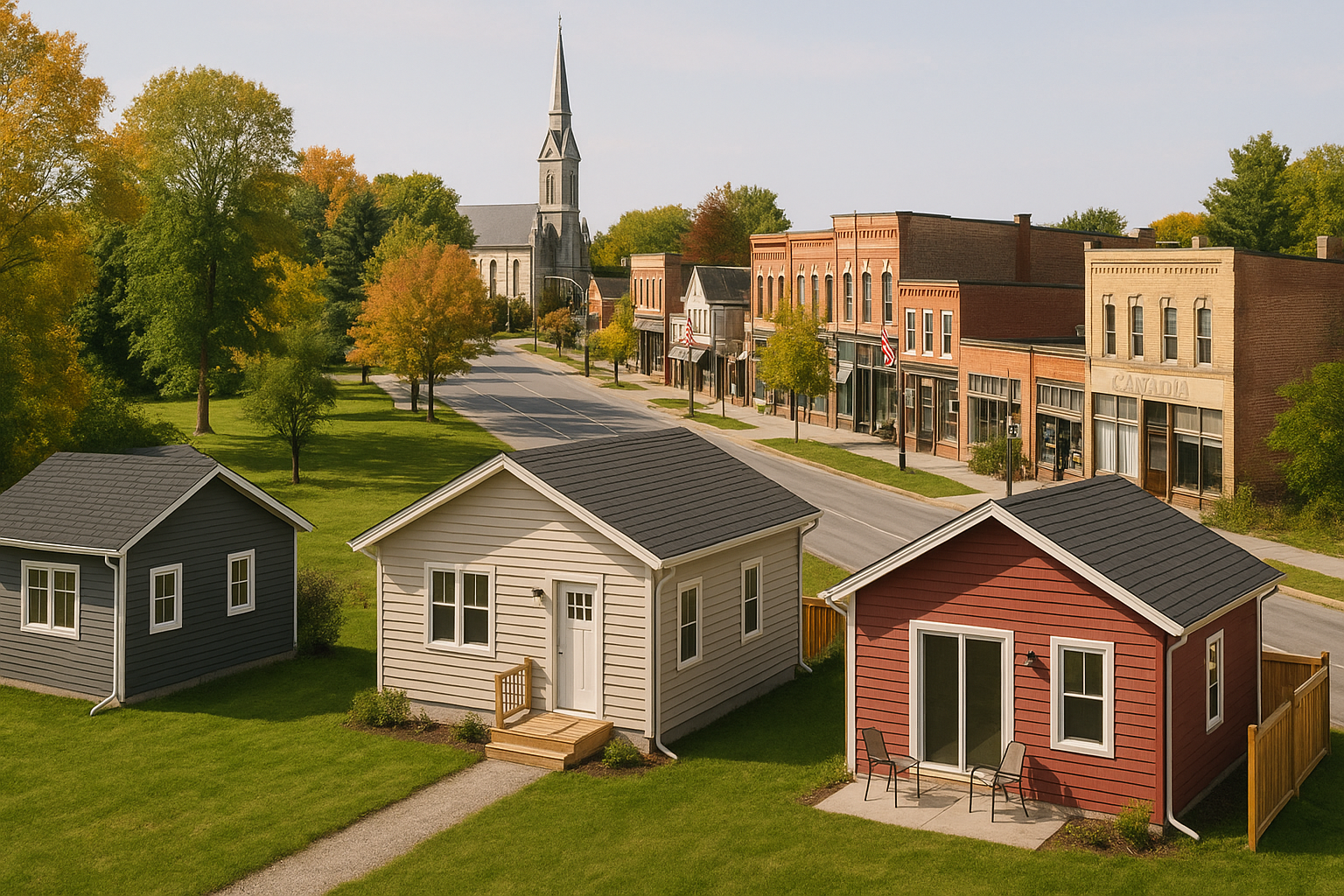
How Rural ADUs Can Drive Small Town Revitalization and Main Street Housing in Canada
Estimated reading time: 8 minutes
Key Takeaways
- Rural ADUs provide affordable and flexible housing solutions while preserving community character.
- They support small town revitalization by gently increasing population density.
- ADUs bolster main street housing by boosting local business and enhancing neighborhood safety.
- Proper regulation and creative conversions ensure that ADUs blend with rural landscapes and heritage.
- Community engagement, municipal support, and innovative financing are critical for successful ADU implementation.
Table of Contents
Rural ADUs (Accessory Dwelling Units) are secondary living spaces on a property—commonly called garden suites, granny flats, or backyard cottages. These independent homes share much with the main house and are gaining widespread attention in Canada for their ability to address housing shortages while maintaining local character. Recent research summarizes ADUs as smaller dwellings built beside or attached to a principal residence, offering flexible spaces for rental or family use from CentrIs.
Main street housing refers to residential options near a town’s primary commercial area, supporting business opportunities, walkability, and neighborhood vibrancy. As towns seek revitalization, rural ADUs present a compelling solution to increase density, support local businesses, and drive holistic community development.
This blog will break down what rural ADUs are, their impact on small town revitalization, their role in fostering main street housing, and actionable strategies for municipalities and homeowners to implement them efficiently.
Understanding Rural ADUs: Definition and Types in Canada
What Are Rural ADUs?
Rural ADUs are small, self-contained housing units built on the same lot as a primary dwelling. These units may be detached cottages, connected additions, or conversions of existing spaces such as garages or barns. In the rural Canadian context, they:
- Provide flexible, affordable housing options
- Blend with the existing landscape and architectural style
- Offer housing for extended family, renters, or seasonal workers
By making efficient use of land, ADUs help communities add housing without encroaching on precious farmland or wilderness. They appeal to a wide range of residents—from seniors and young families to students and seasonal workers. Source: CentrIs
For further insights on maximizing property value through secondary living spaces, explore How a Secondary Unit Can Boost Property Value and Rental Income: Key Benefits for Canadian Homeowners.
Types of ADUs Suitable for Rural Settings
Rural ADUs in Canada generally fall into three categories:
- Detached units: Standalone structures such as tiny homes, cottages, or modular suites—ideal for spacious lots with separate access.
- Attached units: Extensions to the main house, built on the side, back, or above a garage, offering privacy while maintaining connection to the primary dwelling.
- Conversions: Reusing existing spaces like garages, barns, or basements, offering an economical way to add housing.
Additional in-depth information on creative ADU conversions is provided by North Bay FAQ and detailed guidance can also be found in Garage Conversion: A Comprehensive Canadian Homeowner’s Guide to Creating Legal ADUs and Secondary Suites.
Regulatory Environment and Zoning Considerations
Local rural municipalities set guidelines to balance expansion with community character. Common regulatory requirements include:
- One ADU per lot: Most rural areas permit a single ADU per property.
- Zoning compliance: ADUs must adhere to local zoning bylaws, setback rules, minimum lot sizes, and parking requirements.
- Building code standards: ADUs must comply with provincial building codes concerning safety, fire, and accessibility.
- Community fit: ADUs should enhance, not disrupt, the neighborhood character and property values.
Integrating rural ADUs into community development helps support new and longstanding residents. More details can be found at North Bay FAQ and CentrIs. For an extensive provincial overview, consult Canadian ADU Regulations: A Comprehensive Provincial Guide.
The Role of Rural ADUs in Small Town Revitalization
Increasing Population Density Through Rural ADUs
Rural ADUs allow towns to gradually increase population density—adding residents via one or two carefully planned ADUs per lot. This gentle densification:
- Bolsters school enrollment and supports local programs
- Introduces new residents without overburdening infrastructure
- Enhances community diversity and vibrancy
A modest rise in population can trigger significant improvements in local safety, community activities, and municipal services.
Affordable Housing Solutions With Rural ADUs
ADUs are key to offering affordable housing through their versatile use:
- Youth and first-time homeowners: Lower costs make ADUs an attractive transition home.
- Seniors: Enable age-in-place living to reduce isolation and care expenses.
- Essential workers: Provide housing close to work for teachers, nurses, and retail employees.
These options not only attract newcomers but also help retain committed local residents. Learn more about affordable solutions in Affordable Housing: Innovative Solutions and Practical Strategies for Budget-Friendly Homes.
Economic Impact: Fueling Community Development
Each new ADU contributes to the local economy by:
- Raising demand in local groceries, eateries, cafes, and shops
- Attracting new talents and inspiring start-up businesses
- Promoting walkability which keeps spending within the town core
This economic stimulation strengthens community resilience. For further examples on ADU economic benefits, see ADU Income Case Studies: Real-Life Examples Showing Rental ROI in Canadian Suburban Properties.
Supporting Main Street Housing with Rural ADUs
Linking ADU Development to Main Street Renewal
By situating ADUs near central business corridors, communities can:
- Revitalize neglected or underused lots by converting backyards and garages
- Create more “eyes on the street” for enhanced safety and community engagement
- Preserve heritage and local architecture while accommodating new residents
This strategic placement results in a livelier, more attractive main street. For additional ideas on combining living and workspace, refer to Home Office Solutions: How ADU Offices and Backyard Workspaces Boost Remote Work Productivity.
Enhancing Local Business Viability With Main Street Housing
ADU-driven residential growth translates into:
- An increased customer base for local shops and restaurants
- More support for pop-up markets and community events
- Opportunities for innovative mixed-use developments
When residents live within walking distance of daily amenities, they are more likely to invest in and support the local economy.
Practical Strategies for Community Development Using Rural ADUs
Encouraging Rural Property Owners to Build ADUs
Homeowners can play a pivotal role by:
- Recognizing rental income potential: ADUs can provide a steady income stream over time.
- Enhancing property value: Secondary suites appeal to future buyers and multi-generational families.
- Taking part in community revitalization: Each ADU strengthens local services and amenities.
For detailed rental optimization tips, check out Optimizing Your Rental Unit for Maximum Profitability: A Comprehensive Guide.
Engaging Municipal Governments for ADU-Friendly Policies
Local governments can foster ADU growth by:
- Simplifying zoning and permitting: Streamline red tape and clarify guidelines.
- Flexible regulations: Adapt regulations on size, parking, and setbacks for rural contexts.
- Active promotion: Offer guides, case studies, and workshops to demystify the process.
Municipalities such as Toronto and North Bay are leading the way. Read more on municipal initiatives at Novacon and ADU Permitting in Ontario: A Comprehensive Guide for Homeowners.
Financing Options and Incentives for Rural ADUs
To mitigate upfront costs, property owners can explore:
- Public grants and loans: Available funding for affordable or senior housing units.
- Tax credits: Deductions available for renovations that improve accessibility or green standards.
- Reduced development fees: Some municipalities offer waivers on connection fees or incentives for sustainable builds.
Detailed financing strategies are outlined in The Ultimate Guide to ADU Financing Canada.
Community Education and Workshops About Rural ADUs
Raising awareness is key. Effective strategies include:
- Hosting informational workshops and guided tours
- Distributing comprehensive educational materials
- Sharing real-life success stories to inspire homeowners
For an example of community engagement, see How to Create Effective Tiny Home Community Workshops: A Step-by-Step Guide for Canadian Neighborhoods.
Case Studies: Rural ADUs Revitalizing Canadian Small Towns
North Bay, Ontario: A Model for Rural ADUs
North Bay offers a pragmatic model by allowing one ADU per lot with options for both attached and detached units, as well as conversions of existing structures. Early impacts include:
- Increased rental housing particularly for seniors and young professionals
- Steady population growth supporting local schools and services
- Enhanced main street economic activity due to additional local spending
- Efficient use of existing infrastructure with minimal strain
Homeowners find the process manageable, with robust support from municipal planning as highlighted by North Bay FAQ.
Other Canadian Small Towns Embracing ADUs
Across Ontario and British Columbia, communities such as Guelph, Bracebridge, Prince Edward County, Nelson, and Revelstoke are updating zoning bylaws and initiating programs that promote detached suites and backyard cottages. These initiatives increase housing diversity, retain young population members, and stimulate local commerce.
Additional success stories and homeowner experiences can be explored in Accessory Dwelling Units: The Ultimate Guide to ADUs for Canadian Property Investment and Canadian ADU Stories: Inspiring Successes, Homeowner Experiences, and Tiny Home Renovation Insights.
Conclusion: Rural ADUs Are Keys to Small Town Revitalization and Main Street Housing in Canada
Rural ADUs present a practical, scalable solution for addressing housing shortages while boosting local economies and main street vitality. They gently increase population density, diversify housing options, and drive economic and community development in Canadian small towns.
For property owners and community leaders, the roadmap is clear:
- Explore the potential of incorporating an ADU into your property
- Consult local zoning bylaws and building codes for compliance
- Engage with municipal planning offices to access updated guides and incentives
- Participate in community education and share success stories
- Advocate collectively for flexible ADU-friendly policies
By uniting homeowners, municipal officials, and community advocates, rural ADUs can serve as a cornerstone for small town revitalization, main street renewal, and sustainable community growth.
For more information:
CentrIs: What do you know about accessory dwelling units?
North Bay ADU FAQs
Novacon: Understanding accessory dwelling units in Toronto
Frequently Asked Questions
1. What exactly is a Rural ADU?
Rural ADUs are self-contained housing units built on the same lot as a main dwelling. They can be detached cottages, attached extensions, or conversions of existing spaces like garages or barns.
2. How do Rural ADUs contribute to small town revitalization?
By gently increasing population density, ADUs boost local economic activity, support schools and services, and help maintain vibrant main street areas.
3. What regulatory considerations should homeowners be aware of?
Local zoning bylaws, building codes, setback requirements, and community fit are key. It is crucial to consult municipal planning offices for tailored guidelines.
4. Can Rural ADUs provide affordable housing solutions?
Yes. ADUs offer versatile, cost-effective housing options for young families, seniors, and essential workers, helping counter rising housing shortages.
5. What role do municipal governments play?
Municipalities can simplify permitting processes, offer tax incentives, and actively promote ADU developments, making it easier for homeowners to build ADUs.

Leave a Reply